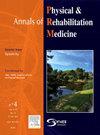Effect of respiratory rehabilitation on quality of life in individuals with post-COVID-19 symptoms: A randomised controlled trial
IF 4.6
3区 医学
Q1 REHABILITATION
Annals of Physical and Rehabilitation Medicine
Pub Date : 2025-02-01
DOI:10.1016/j.rehab.2024.101920
引用次数: 0
Abstract
Background
Inspiratory and expiratory muscle training (RMT) has been shown to have beneficial effects in individuals with long-term post-COVID-19 symptoms.
Objective
To assess the effects of adding RMT to an aerobic exercise (AE) training program for health-related quality of life (HRQoL) and exercise tolerance in individuals with long-term post-COVID-19 symptoms, and to evaluate the effects on physical and lung function, and psychological status.
Methods
64 individuals with long-term post-COVID-19 symptoms of fatigue and dyspnoea were randomly assigned to AE+RMT or AE+RMTsham groups for an 8-wk intervention (AE: 50min/day, 2 times/wk; RMT: 40min/day, 3 times/wk). Primary outcomes were HRQoL (EuroQol-5D questionnaire) and exercise tolerance (cardiopulmonary exercise test). Secondary outcomes were physical function: respiratory muscle function (inspiratory/expiratory muscle strength and inspiratory muscle endurance), lower and upper limb strength (1-min Sit-to-Stand and handgrip force); lung function: spirometry testing and lung diffusing capacity; and psychological status (anxiety/depressive levels).
Results
Postintervention, there were no statistically significant improvements in HRQoL or exercise tolerance in the AE+RMT compared with the AE+RMTsham group. In the AE+RMT group, large improvements in respiratory muscle function (d = 0.7 to 1.3) and low-moderate improvements in peak expiratory flow (d = 0.4) occurred compared with the AE+RMTsham group. Lung function outcomes, lower and upper limb strength and psychological status did not increase more in the AE+RMT group than in the AE+RMTsham group.
Conclusion
For individuals with long-term post-COVID-19 symptoms, combining RMT with an AE training program resulted in improvements in respiratory muscle strength, inspiratory muscle endurance and peak expiratory flow; however, the differences between groups were not statistically significant for HRQoL, exercise tolerance, psychological distress, and lung diffusing capacity.
Database registration
United States Clinical Trials Registry (NCT05597774)
呼吸康复对covid -19后症状患者生活质量的影响:一项随机对照试验
背景:吸气和呼气肌训练(RMT)已被证明对长期出现covid -19后症状的个体有益。目的:评估在有氧运动(AE)训练计划中加入RMT对covid -19后长期症状患者健康相关生活质量(HRQoL)和运动耐量的影响,并评估其对身体和肺功能以及心理状态的影响。方法:将64例长期出现covid -19后疲劳和呼吸困难症状的患者随机分为AE+RMT组或AE+RMTsham组,进行8周的干预(AE: 50分钟/天,2次/周;RMT: 40分钟/天,3次/周)主要结局为HRQoL (EuroQol-5D问卷)和运动耐量(心肺运动试验)。次要结局是身体功能:呼吸肌功能(吸气/呼气肌力量和吸气肌耐力)、下肢和上肢力量(1分钟坐立和握力);肺功能:肺活量测定和肺弥散能力;以及心理状态(焦虑/抑郁水平)。结果:干预后,与AE+RMTsham组相比,AE+RMT组HRQoL和运动耐量无统计学意义的改善。与AE+RMTsham组相比,AE+RMT组呼吸肌功能有较大改善(d = 0.7 ~ 1.3),呼气峰流量有中低改善(d = 0.4)。AE+RMT组肺功能结局、下肢和上肢力量和心理状态的增加并不比AE+RMTsham组多。结论:对于长期出现covid -19后症状的个体,将RMT与AE训练计划相结合可改善呼吸肌力量、吸气肌耐力和呼气峰值流量;然而,在HRQoL、运动耐量、心理困扰和肺弥散能力方面,组间差异无统计学意义。数据库注册:美国临床试验注册中心(NCT05597774)。
本文章由计算机程序翻译,如有差异,请以英文原文为准。
求助全文
约1分钟内获得全文
求助全文
来源期刊

Annals of Physical and Rehabilitation Medicine
Medicine-Rehabilitation
CiteScore
7.80
自引率
4.30%
发文量
136
审稿时长
34 days
期刊介绍:
Annals of Physical and Rehabilitation Medicine covers all areas of Rehabilitation and Physical Medicine; such as: methods of evaluation of motor, sensory, cognitive and visceral impairments; acute and chronic musculoskeletal disorders and pain; disabilities in adult and children ; processes of rehabilitation in orthopaedic, rhumatological, neurological, cardiovascular, pulmonary and urological diseases.
 求助内容:
求助内容: 应助结果提醒方式:
应助结果提醒方式:


